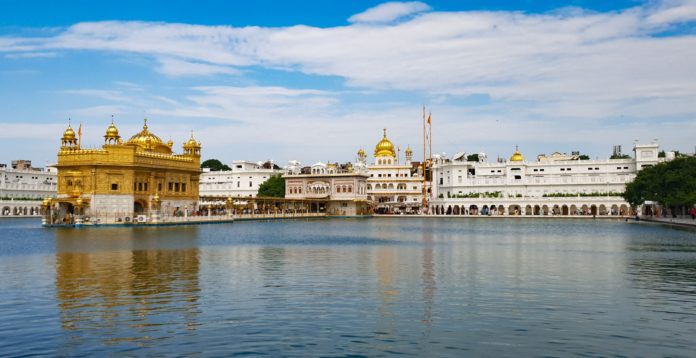Harmandir Sahib, the abode of God, commonly known as the Golden Temple is located in Amritsar, Punjab. The Gurudwara is a place of faith and worship for everyone. It has four entrances, depicting people from all four directions are welcome and people of all four castes are equal. The four doors are termed as doors of peace, livelihood, learning and grace.
Ian R. Kerr, a Canadian academic and other scholars rightly pointed out that Gurudwara is a mixture of the Indo-Islamic Mughal and the Hindu Rajput architecture. The temple is surrounded by 154.5×148.5 square metre Sarovar which is 5.1m deep. The foundation stone of the Sarovar was kept in 1589 by Sai Mir Mian Mohammad, a Muslim Pir of Lahore on request of Guru Arjan Dev ji. The way to the temple is a long passage which begins from Darshani Deorhi or Darshana Dwara. The two-storey temple covers 12.25×12.25 square metre area and has a gold foil dome. The floor is fixed with white marble and raised a little above the entrance way. The gold plated doors and frescos of the shrine are covered with nature motifs like flowers, birds and animals and are fully geometrical. The upper floor of the shrine is a gallery and its ceiling is embossed and decorated with gold ornaments. The motifs embossed in marbles and gilded walls of the sanctum are Arabesque. The walls are brightened with the murals of Gurus for instance, Guru Gobind Singh ji carrying a falcon and riding a horse.
The complex comprises several buildings which are popular amongst pilgrims as they are sites of worship. The Ath Sath Tirath behind the Golden Temple is a spot believed to be equivalent to 68 pilgrimages sites. The strong belief of taking a dip under the Dukh Bhanjani Ber tree clears all the sufferings. People carry the sacred water for their sick loved ones. There are two more trees inside the complex. One, Baba Buddha Sahib Ji Ber tree near the museum and another Laachi Ber tree near Darshani Deorhi, where Guru Arjan Dev ji rested at the time of construction of the temple. One of the primary Takth, the Akal Takth Sahib is situated in front of the Harmandir Sahib and its causeway. The Akal Takth Sahib means throne of timeless God, is the central authority of Sikhism and all the issues related to the Dharma are resolved here. It is additionally the central command of the fundamental ideological group of the Indian territory of Punjab, Shiromani Akali Dal. The Akal Takth Sahib occupies the supreme seat and highest authority in the complex.
The Tharra Sahib, shrine of Guru Teg Bhadur Sahib ji is situated near the building of the Akal Takth Sahib. Behind the Ath Sath Tirath a causeway heads towards the Clock Tower, Langar Hall, Manji Sahib Dewan Hall, Teja Singh Samudri Hall and several inns. John Gordon, the Municipal Chief Engineer of Amritsar designed the Clock Tower as eastern architectural designs of Cathedral, and the new clock tower was built in the traditional European Gothic style with red bricks. It became famous with the name of Lal Chabutra. With so many changes in structure and architecture of the complex, one can notice the clear difference in the design of the tower as it is totally changed. This construction is presently the primary access to the Harmandir Sahib and it houses a gallery, a clock, and commonly known as ‘Ghanta Ghar Deori’.
Guru Ramdas Langar Hall or Community Kitchen is popular for various reasons. One of the reasons is that it feeds more than one lakh people daily, irrespective of race, caste, religion, and other divisional factors. The operators follow the guidelines of langar introduced by Guru Nanak Dev Ji and carried forward by Guru Amar Das Ji and other gurus. When Akbar came to meet Guru Amar Das ji, Guru Ji told Akbar to have langar first by saying “Phle Pangat pache Sangat.” Vegetarian meals are served all day and night, and all days of the year. Opposite of Guru Ramdas Langar Hall, Diwan Hall Gurudwara Manji Sahib is a congregation hall where the daily ‘Hukamnama Sahib’ or ‘Order -of-the-Day’ is explained to the worshippers. The hymns of Guru Granth Sahib Ji are sung in Harmandir Sahib whereas the Bani or hymns are explained in Manji Hall. Guru Arjan Dev Ji recited Bara Mah that is, a bani explaining the twelve months of the year as per the lunar calendar. He started the concept of explaining Bani and this is being carried forward by the Granthis and other Gianis who are capable of explaining the teachings of the Gurus.
Near the Langar Hall and Manji Hall, the Teja Singh Samudri Hall is the head office of the Shriomani Gurudwara Prabandhak Committee. All the major actions regarding the Gurudwara are taken up by committee. The hall is surrounded by 2 inns on both sides. On the right of the hall, Guru Arjan Dev Niwas and Guru Ramdas Sarai are there and on its left Guru Nanak Niwas and Guru Hargobind Niwas are situated. Beside Guru Hargobind Niwas, an octagonal nine-storeyed building known as Gurudwara Baba Atal Rai is situated. The 9 floor highlights the 9 years of life of Baba Atal Rai Ji, son of Guru Hargobind Ji. The walls of the Gurudwara are decorated with frescos of Guru Nanak Dev Ji’s life. It is one of the tallest buildings of Amritsar and the view of the city from the topmost floor is incredible.
To sum up, the Golden Temple with all its grandeur and glory, is one of the most magnificent architectural masterpieces in the world. Its beauty, in my opinion, remains unparalleled to any other. Along with its structural splendour, the moral value associated with its teachings run deep across generations.
By Avleen Kaur, Faridabad












Very well describe. God bless you
Waheguru ❤️
Very nice
Waheguru ❤️
Well done Avleen! True wordings.. Keep going! May Waheguru ji always bless you… ❤✨
Dhan guru ramdas ji ❤
Nice thought avleen di
Nice didi
Nice thought avleen di
Nice di
Didi it is nice
Woww
Woww
Written beautifully
Very knowledgeable
Outstanding Article. I appreciated your efforts for collecting information about history and glory of Harmandir sahib.congratulations Avleen kaur for excellent article ……waiting for more informative articles
Beautifully written. Keep up the good work.
Beautiful
❤️❤️